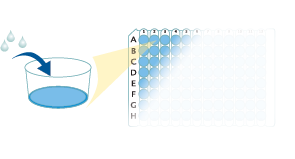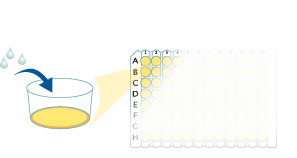Mouse/Rat TNF RII/TNFRSF1B Quantikine ELISA Kit Summary
Product Summary
Precision
Cell Culture Supernates, Serum, EDTA Plasma
| Intra-Assay Precision | Inter-Assay Precision | |||||
|---|---|---|---|---|---|---|
| Sample | 1 | 2 | 3 | 1 | 2 | 3 |
| n | 20 | 20 | 20 | 20 | 20 | 20 |
| Mean (pg/mL) | 37.2 | 112 | 472 | 38.6 | 119 | 500 |
| Standard Deviation | 1.5 | 4.4 | 21 | 1.4 | 3.5 | 14.7 |
| CV% | 4 | 3.9 | 4.4 | 3.6 | 2.9 | 2.9 |
Recovery
The recovery of TNF RII spiked to levels throughout the range of the assay in various matrices was evaluated.
| Sample Type | Average % Recovery | Range % |
|---|---|---|
| Mouse Cell Culture Supernates (n=5) | 102 | 83-119 |
| Mouse EDTA Plasma (n=5) | 95 | 80-119 |
| Mouse Serum (n=5) | 99 | 91-105 |
| Rat Cell Culture Supernates (n=5) | 98 | 85-116 |
| Rat EDTA Plasma (n=5) | 95 | 83-112 |
| Rat Serum (n=5) | 97 | 84-114 |
Linearity
Scientific Data
Product Datasheets
Preparation and Storage
Background: TNF RII/TNFRSF1B
TNF RII (Tumor Necrosis Factor Receptor II), also known as TNFRSF1B, p75/p80, and CD120b, is a widely expressed receptor for membrane-associated TNF-alpha and Lymphotoxin-alpha. Its activation initiates pro-inflammatory and pro-survival responses via NFkB-dependent signaling pathways, although it may also induce apoptosis.
Assay Procedure
Refer to the product- Prepare all reagents, standard dilutions, and samples as directed in the product insert.
- Remove excess microplate strips from the plate frame, return them to the foil pouch containing the desiccant pack, and reseal.
- Add 50 µL of Assay Diluent to each well.
- Add 50 µL of Standard, Control, or sample to each well. Cover with a plate sealer, and incubate at room temperature for 2 hours.
- Aspirate each well and wash, repeating the process 4 times for a total of 5 washes.
- Add 100 µL of Conjugate to each well. Cover with a new plate sealer, and incubate at room temperature for 2 hours.
- Aspirate and wash 5 times.
- Add 100 µL Substrate Solution to each well. Incubate at room temperature for 30 minutes. PROTECT FROM LIGHT.
- Add 100 µL of Stop Solution to each well. Read at 450 nm within 30 minutes. Set wavelength correction to 540 nm or 570 nm.





Citations for Mouse/Rat TNF RII/TNFRSF1B Quantikine ELISA Kit
R&D Systems personnel manually curate a database that contains references using R&D Systems products. The data collected includes not only links to publications in PubMed, but also provides information about sample types, species, and experimental conditions.
16
Citations: Showing 1 - 10
Filter your results:
Filter by:
-
Neuroprotective Effect of Dexmedetomidine against Postoperative Cognitive Decline via NLRP3 Inflammasome Signaling Pathway
Authors: I Cho, BN Koo, SY Kim, S Park, EJ Kim, EH Kam, J Kim
International Journal of Molecular Sciences, 2022-08-08;23(15):.
Species: Mouse
Sample Types: Tissue Homogenates
-
The sodium-glucose cotransporter 2 inhibitor tofogliflozin prevents diabetic kidney disease progression in type 2 diabetic mice
Authors: Z Li, M Murakoshi, S Ichikawa, T Koshida, E Adachi, C Suzuki, S Ueda, T Gohda, Y Suzuki
FEBS Open Bio, 2020-11-10;0(0):.
Species: Mouse
Sample Types: Serum
-
Macrophage-derived tumor necrosis factor-alpha mediates diabetic renal injury.
Authors: Awad A, You H, Gao T, Cooper T, Nedospasov S, Vacher J, Wilkinson P, Farrell F, Brian Reeves W
Kidney Int, 2015-06-10;88(4):722-33.
Species: Mouse
Sample Types: Tissue Homogenates
-
Expression of HIV transgene aggravates kidney injury in diabetic mice.
Authors: Mallipattu S, Liu R, Zhong Y, Chen E, D'Agati V, Kaufman L, Ma'ayan A, Klotman P, Chuang P, He J
Kidney Int, 2013-01-16;83(4):626-34.
Species: Mouse
Sample Types: Serum
-
Restoration of regenerative osteoblastogenesis in aged mice: modulation of TNF.
Authors: Wahl EC, Aronson J, Liu L, Fowlkes JL, Thrailkill KM, Bunn RC, Skinner RA, Miller MJ, Cockrell GE, Clark LM, Ou Y, Isales CM, Badger TM, Ronis MJ, Sims J, Lumpkin CK
J. Bone Miner. Res., 2010-01-01;25(1):114-23.
Species: Mouse
Sample Types: Serum
-
Fat diet and alcohol-induced steatohepatitis after LPS challenge in mice: role of bioactive TNF and Th1 type cytokines.
Authors: Olleros ML, Martin ML, Vesin D, Fotio AL, Santiago-Raber ML, Rubbia-Brandt L, Spahr L, Hadengue A, Garcia I
Cytokine, 2008-08-22;44(1):118-25.
Species: Mouse
Sample Types: Serum
-
Hypoxia enhances lysosomal TNF-alpha degradation in mouse peritoneal macrophages.
Authors: Lahat N, Rahat MA, Kinarty A, Weiss-Cerem L, Pinchevski S, Bitterman H
Am. J. Physiol., Cell Physiol., 2008-04-23;295(1):C2-12.
Species: Mouse
Sample Types: Cell Culture Supernates
-
Differential roles of p55 and p75 tumor necrosis factor receptors on stretch-induced pulmonary edema in mice.
Authors: Wilson MR, Goddard ME, O'Dea KP, O'Dea KP, Choudhury S, Takata M
Am. J. Physiol. Lung Cell Mol. Physiol., 2007-04-13;293(1):L60-8.
Species: Mouse
Sample Types: BALF
-
Bacterial translocation is downregulated by anti-TNF-alpha monoclonal antibody administration in rats with cirrhosis and ascites.
Authors: Frances R, Chiva M, Sanchez E, Gonzalez-Navajas JM, Llovet T, Zapater P, Soriano G, Munoz C, Balanzo J, Perez-Mateo M, Song XY, Guarner C, Such J
J. Hepatol., 2006-12-27;46(5):797-803.
Species: Rat
Sample Types: Serum
-
The shedding activity of ADAM17 is sequestered in lipid rafts.
Authors: Tellier E, Rebsomen L
Exp. Cell Res., 2006-09-05;312(20):3969-80.
Species: Mouse, Rat
Sample Types: Cell Lysates, Tissue Homogenates
-
FHL2 interacts with both ADAM-17 and the cytoskeleton and regulates ADAM-17 localization and activity.
Authors: Canault M, Tellier E, Bonardo B, Mas E, Aumailley M, Juhan-Vague I, Nalbone G, Peiretti F
J. Cell. Physiol., 2006-08-01;208(2):363-72.
Species: Mouse
Sample Types: Cell Lysates
-
Nrf2 is a critical regulator of the innate immune response and survival during experimental sepsis.
Authors: Thimmulappa RK, Lee H, Rangasamy T, Reddy SP, Yamamoto M, Kensler TW, Biswal S
J. Clin. Invest., 2006-04-01;116(4):984-95.
Species: Mouse
Sample Types: Serum
-
Role of tumour necrosis factor-alpha receptor p75 in cigarette smoke-induced pulmonary inflammation and emphysema.
Authors: D'hulst AI, Bracke KR, Maes T, De Bleecker JL, Pauwels RA, Joos GF, Brusselle GG
Eur. Respir. J., 2006-03-15;28(1):102-12.
Species: Mouse
Sample Types: BALF
-
Systemic up-regulation of sTNFR2 and IL-6 in Porphyromonas gingivalis pneumonia in mice.
Authors: Petelin M, Naruishi K, Shiomi N, Mineshiba J, Arai H, Nishimura F, Takashiba S, Murayama Y
Exp. Mol. Pathol., 2004-02-01;76(1):76-81.
Species: Mouse
Sample Types: Serum
-
The protein tyrosine kinase inhibitor AG126 prevents the massive microglial cytokine induction by pneumococcal cell walls.
Authors: Hanisch UK, Prinz M, Angstwurm K, Hausler KG, Kann O, Kettenmann H, Weber JR
Eur. J. Immunol., 2001-07-01;31(7):2104-15.
Species: Mouse
Sample Types: Cell Culture Supernates
-
Enhanced murine macrophage TNF receptor shedding by cytosine-guanine sequences in oligodeoxynucleotides.
Authors: Jin L, Raymond DP, Crabtree TD, Pelletier SJ, Houlgrave CW, Pruett TL, Sawyer RG
J. Immunol., 2000-11-01;165(9):5153-60.
Species: Mouse
Sample Types: Cell Culture Supernates
FAQs
No product specific FAQs exist for this product, however you may
View all ELISA FAQsReviews for Mouse/Rat TNF RII/TNFRSF1B Quantikine ELISA Kit
Average Rating: 5 (Based on 1 Review)
Have you used Mouse/Rat TNF RII/TNFRSF1B Quantikine ELISA Kit?
Submit a review and receive an Amazon gift card.
$25/€18/£15/$25CAN/¥75 Yuan/¥2500 Yen for a review with an image
$10/€7/£6/$10 CAD/¥70 Yuan/¥1110 Yen for a review without an image
Filter by:









